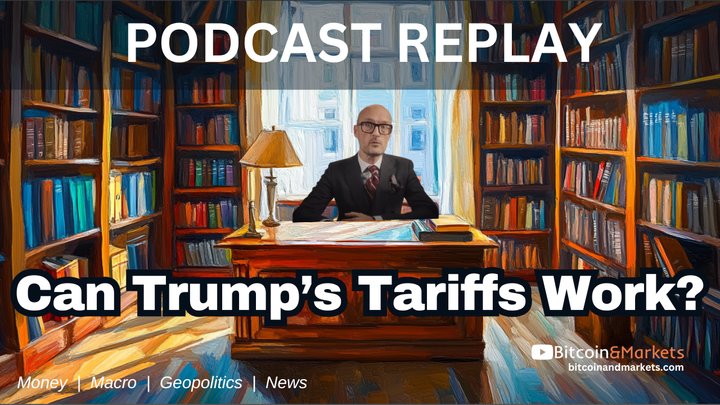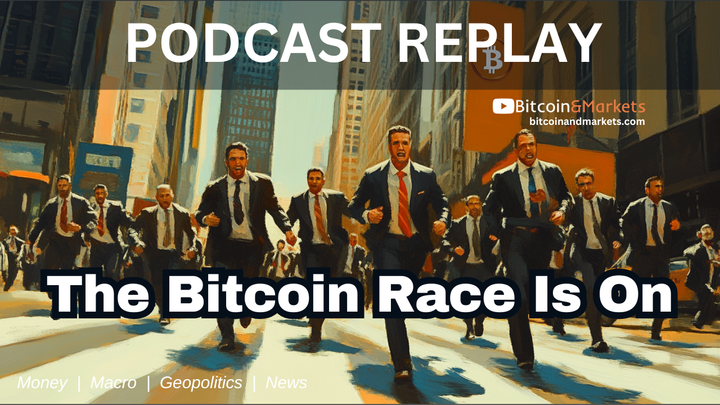Economic Fallacies of Ethereum as Ultra Sound Money - E229
This episode helps you understand the criticisms of Ethereum's Ultra Sound Money (USM) thesis.

Hopefully this episode helps you understand the criticisms of Ethereum's Ultra Sound Money (USM) thesis.
In this episode I focus on answering the criticism present in the USM thesis from a bitcoin perspective. I start with introducing the listener to the idea of USM and economic engines. Then I dive into the ways to power the engine with issuance or fees, and some of the fallacies around that. Next, we look at Proof of Work (mining) versus Proof of Stake (what ethereum wants to go to). Lastly, is a quick discussion on EIP 1559, the proposal in Ethereum to burn transaction fees as a way to deflate supply.
Episode links below.
What is Sound Money?
Ultra Sound Money is meant to be money that is anti-inflationary to the point of the being deflationary, along with aspects of claimed efficient security. Sound money, however, is not really about that, it is specifically money that arises naturally on the market and has a stable purchasing power. For a money to have a stable purchasing power, the supply must be somewhat elastic, to flex with times of high demand for money and low demand.
For example, gold is not sound money because it has no inflation, it is sound money because the inflation rate responds to market incentives to produce a stable purchasing power. Gold mining will increase as purchasing power increases and decrease (or enter hoards out of circulation) as purchasing power decreases. The unique combination of properties which gold has, not easy to inflate but still able to respond somewhat to price increases, created a stable value over the decades and centuries of its use. It was the inflation regulator that allowed gold to maintain a stable price.
This USM thesis, therefore, would need to compete against gold's stable purchasing power to be considered sound money.
Bitcoin claims to be hard money, not sound money. Bitcoin's fixed supply will most likely lead to it consistently appreciating in value, not a stable purchasing power.
Economic Engine
In the USM thesis the economy is like an engine that is fed energy inputs and creates productive outputs. There are several roles played in this engine, governance, production and defense. These three things are woven together to move everyone forward together in some social contract that manifests itself in a network GDP of sorts.
The main role the USM focuses on is defense. Defense is something that must be paid for, and the most security for the lowest cost is the most efficient defense. The focus on security is interesting because it's not defined anywhere in the source material that I noticed. That's important because it is a huge difference between bitcoin and ethereum lines of thought.
Bitcoin views security as the maintaining the rules of the system. If the rules are maintained, bitcoin remains a natural part of the market and everything else will fall in place along its aligned incentives. For Ethereum, security is about "liveness" and continuing to finalize blocks according to a nebulous social contract. They don't care about the rules. (Side note: this is very important when judging the legitimacy of monetary policy)
Ways to Fund the Security of the Economic Engine
There are two ways to fund the security of the economic engine. Again, we don't know exactly what this means, but let's say it means the continued operation of the network. Those two sources of funding according the USM thesis are issuance and transaction fees.
They claim issuance is preferable, pure energy, long term stable, and predictable. This is not the case. Issuance is inflationary and causes price depreciation of the money. The Ethereum folks get that and reply that they will take out supply elsewhere by burning transaction fees, seemingly unaware of the other ills of inflation, namely the distortion of the capital structure and Cantillon effects. Economic activity, investment, and the capital structure will be distorted to favor the source of the inflation (in ethereum's case that would be staking in Proof of Stake (PoS)).
Issuance is also not exactly predictable either. It is random for the individual and the network as a whole. There is a chance that you won't be able to produce a block for very long periods, or you may be selected to produce more blocks than predicted. It is only in the long run where the effect of the random nature can be effectively ignored. The network faces this same struggle too, only its "long run" is shorter than an individuals.
Transaction fees are the second way to fund security of the economic engine, but is not preferable, inefficient, second-class funding, and unpredictable. This is not entirely the case either. Fees do suffer from the same randomization as issuance, and are slightly less predictable month by month, or quarter by quarter, but in the long run fees too are much more predictable than the USM thesis proposes. They are only slightly less predictable than issuance in the long run.
Ignored about fees in the USM thesis is their market based nature. Fees are paid in transactions for a market based service that block producers provide, unlike issuance. Fees do not distort the market because they are naturally part of the market, dependent not on an artificial "liveness" imperative but on natural supply and demand spanning many industries and markets.
Block production (at least in PoW) is a free market activity, that responds to revenue and costs, there's innovation, and market competition. During times of high demand on the network, fees offer a way for market incentives to influence block producers.
Fees also provide incentive to other aspects of innovation, like Layer 2 apps. Higher fees will naturally pressure people toward off chain apps. These apps like the Lightning Network are not perfect or yet to achieve up to their potential, but there is a dynamic incentive to innovation that can reward and punish success for failure.
Lastly, transaction fees provide the only natural market-based way to fight an empty block attack via a 51% attack. Empty blocks move the network forward. If the goal is to defend the economic activity, the funding should be more rightly thought of as protecting transactions (or smart contract execution) not just blocks. In all the back of napkin math done by USM thesis people, they never take into account this fact (or other market factors) when estimating the cost to attack bitcoin.
Selling Pressure
One of the biggest claims in the USM thesis is that PoW mining is very costly, which forces miners to always be selling their coins to pay for those costs. This puts a downward pressure on the price as miners are always net sellers.
This criticism in made out of ignorance about free market exchange. In a free market, voluntary exchange benefits all parties, because they by definition must value what they are receiving more than what they are giving up for it. Voluntary exchange is a win-win situation.
All natural market forces are regulated by other natural forces through supply and demand and exchange. It's very similar to any ecosystem in that regard. The ecosystem is infinitely complex and if humans come in and try to manage it, they inevitably cause distortions that lead to long term instability.
Miners having to sell their coins is a natural check on other market forces. It also breeds a virtuous cycle of win-win voluntary market transactions, leading to distribution and a floor on economic activity any future business cycles.
Proof of Stake is rent-seeking behavior
The USM thesis advocates openly admit that PoS is getting something for nearly nothing. They don't however, draw the connection from that idea to rent-seeking. Rent-seeking is the worst kind of inefficiency, it is a middle man that drains profits but doesn't provide any additional value.
PoS institutionalizes rent-seeking in a network and will inevitably lead to slower market activity.
EIP 1559
This is the improvement proposal about burning fees. The main idea is that ethereum will rely on issuance as a positive inflation source to power the engine forward, but then 1559 will work on the back end taking supply out of circulation. On net, these two changes should bring the inflation rate negative.
What is overlooked by USM thesis advocates is the distortions from deflation. Exactly opposite to how inflation distorts capital structure towards the source of inflation, the capital structure is distorted away from the source of deflation.
A
Links
First Newsletter
https://newsletter.banklesshq.com/p/eth-is-ultra-sound-money-market-monday-5c4
Second blog post
https://newsletter.banklesshq.com/p/ultra-sound-money-
Hypothesis link https://hyp.is/go?url=https%3A%2F%2Fnewsletter.banklesshq.com%2Fp%2Fultra-sound-money-&group=world
Get The Bitcoin Dictionary!
Bitcoin jargon demystified. Over 180 Bitcoin terms, concepts, and idioms.
The Best Free Bitcoin Newsletter!
Don't miss another issue. Subscribe to the Free tier!
Subscribe to the Pod!
iTunes | Stitcher | Google Pods | YouTube | Soundcloud | RSS
The Show Needs Your Support
We’re a small operation and producing quality content people find valuable.
Check out our big list of ways to help the show
Affiliates
- Chart Like A Pro With TRADINGVIEW
- The Best WordPress Theme I’ve Ever Used! GeneratePress
- Sign Up For Audible And Get 2 FREE Audio Books
Have Feedback? Send it our way.
**DISCLAIMER: This is not investment advice, do your own research.**




